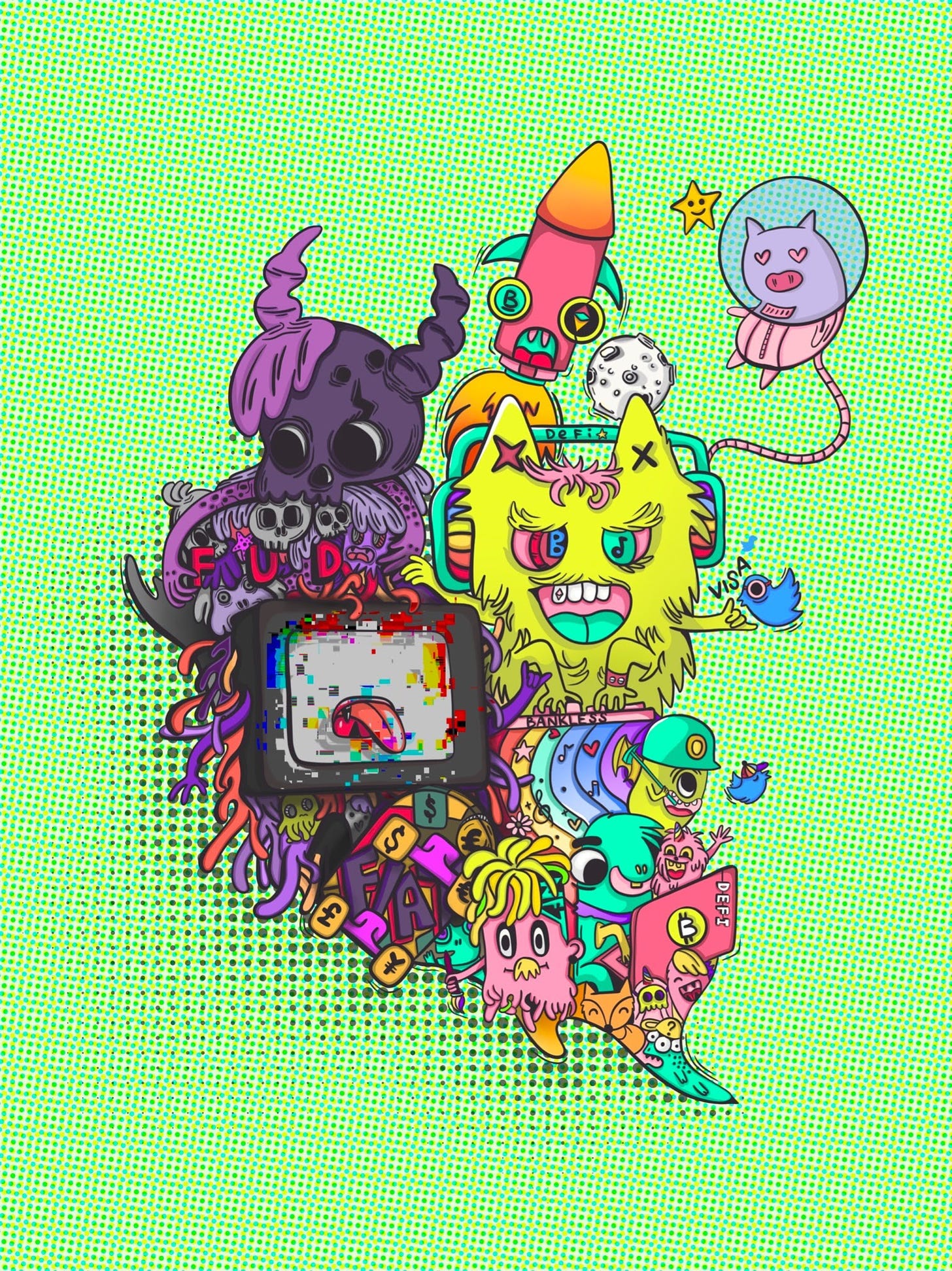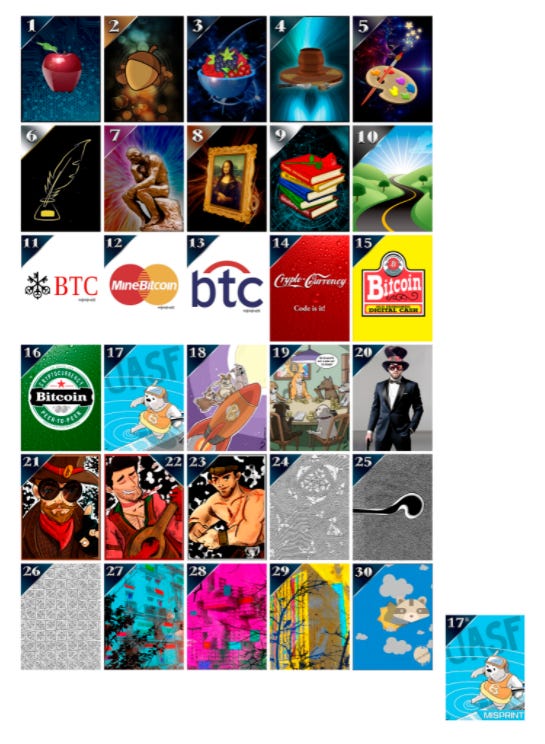Bankless DAO Weekly NFT and Cryptoart Newsletter
Dear Bankless Nation,
If the world and the NFT market never stops, it is thanks to the increasing number of admirers of this new form of art and collecting. This pushes the sector to create something new and more surprising every day, often managing to overcome even the rosiest expectations.
Who would have thought centuries-old and prestigious auction houses would become so involved in NFT sales, among other things, like fine art pieces and collectibles such as CryptoPunks?
And who would have imagined, until a few months ago, that we would see internationally renowned fashion houses, such as Dolce and Gabbana, create NFTs sold at auction through curated marketplaces?
Wherever you turn, whether you are an art or collectibles admirer, an artist, a developer or a market operator, the enthusiasm in the present and in what the near future holds for the NFT world is always growing.
Welcome to Decentralized Arts.
Authors: BanklessDAO Writers Guild (Grendel, Kouros, nonsensetwice)

This is the official NFT newsletter of the Bankless DAO.
Artist of the Week
🧑🎨 Artist: Nittra
🏦 Auction Type: Open edition
💰 Price: 0.02 ETH

bDAO: How did you become a crypto artist?
Nittra: I won a lottery to become a crypto artist. Have you ever watched CSI? I was working as a forensic scientist to identify DNA samples, identifying the true murders and such. But I didn't like it much. So I did the classic way out, I left my dream job and became a freelancer. Last year I heard a lot about Crypto, but I didn't understand it much until I heard what BanklessDAO is about. Create what we love and work together like a community. I felt like I could learn along the way, so I joined without much understanding. I have nothing in my portfolio related to Crypto, but I joined a campaign and I won it. That was the starting point for me. I won a lottery. I found people who loved what I painted and appreciated it. I got GREAT energy from it. I was high from the energy for almost 2 weeks.
bDAO: What does cryptoart mean to you?
Nittra: So I would put that as a Cryptoart definition. The art of doing what you love and a chance of finding a group of people who love what you do. Living is art. Everything we do is art. It depends on how we look and Cryptoart is the place where you can express your arts.
bDAO: What evolution do you see in the world of cryptoart?
Nittra: This is a new world of existing. We found a way to appreciate things further. Creativity has more value now than it ever has. The internet makes the world smaller. People from the other side of the world can talk and communicate in a second. Cryptoart is the next level of it. It's just a matter of time.

bDAO: What do you think about the combination of cryptoart and DAOs?
Nittra: Without his brother, Van Gogh would be a no name artist. His first fan was his brother who believed and always supported him. Without the DAO, I'm nobody. DAO is a community which moves in a similar direction, believes in similar ideas, and stays together. I have really enjoyed every day since I joined the DAO, and creating all of the art I’ve made over the past few weeks.
Curated NFT News
Lil Nas X dropping first official TikTok NFTs:
The first NFTs from TikTok will be the collection "TikTok Top Moments" which will feature six TikTok videos.
Each drop will feature a 1/1 NFT and a limited edition NFTs. Lil Nas X will be the first creator to launch the TikTok NFTs on October 6th with artist Rudy Willingham. A weekly drop will begin after that.
Other creators releasing TikTok NFTs are Bella Poarch, Curtis Roach, Brittany Broski, FNMeka, Jess Marciante and Gary Vaynerchuk.The single edition NFTs will be available on Ethereum mainnet and the limited edition NFTs will be on layer 2 chain, Immutable X.
TikTok added that the majority of the proceeds from the NFT sales will either go to the creators and NFT artists involved or charities.
Christie’s Auctions Curio Cards for $1.3 Million:
One of the first NFT projects in Ethereum, Curio Cards, was launched back in May 2017. There are 30 different cards, with a misprint of card 17 that was generated by error.
Last week, auction house Christies auctioned a complete set of Curio Cards including the 17b card reaching a total sale price of 393 ETH.

Cryptoart Auctions
The advent of fine art NFTs and the rapid growth of the sector has revolutionized the world of art, leading to the emergence of many questions from interested people. Some of these questions have arisen around the relationship between "traditional" auctions and those of NFTs:
- Are classic art auctions and NFT auctions two complementary worlds that will learn to coexist? Or will they remain distinct universes?
- Will NFT auctions replace traditional events?
In the recent months many have asked themselves these kinds of questions.
Perhaps it is still too early to answer, but since the 11th of March this year, the world of auctions has certainly changed.
In fact, on the 11th of March, 2021, Christie's sold Beeple's work "Everydays: The First 5,000 Days" for $69,346,250. It was the first NFT based auction on a digital artwork ever offered by a major auction house.
Two months later, Christie's further consolidated its position as a leader in the world of NFT auctions with the sale of nine Cryptopunks from Larva Labs for $16,962,500.
The London auction house's attention to digital art obviously did not stop and a few days ago, "No Time Like Present" ended, an online sale. This sale was available for 11 days, from the 17th to the 28th of September, which can be considered the first NFT auction organized in Asia by an international auction house.
Among the highlights of the auction were a group of CryptoPunks from Larva Labs defined in the presentation as "exceptionally rare", a series of Meebits from Larva Labs, and a collection of Bored Ape Yacht Club from Yuga Labs.
The other famous UK auction house certainly did not stand by and watch: At the beginning of June this year, Sotheby's organized "Natively Digital: A Curated NFT Sale", a sale of the main NFT artists. For example, Kevin McCoy's "Quantum", the first NFT ever minted (sold for $ 1.5 million), the only existing masked Cryptopunk "Alien" from Larva Labs, and "The Shell Record," by the generative artist Anna Ridler, went up for auction. The offers started at 100 USD, then left the final price to the market and to the passion of collectors. Payments were organized in Bitcoin, Ethereum, and fiat currencies, thanks to the collaboration with Coinbase.
Let us not forget the announcement of Sotheby's collaboration with Pak.
Across the ocean, New York-based Phillps put Mad Dog Jones' "Replicator" up for auction from April 12th to the 23rd, a work that generates new NFTs every 28 days. After a heated battle between 61 potential buyers, the work sold for $ 4.1 million.
The challenge between auction houses reached a higher level of competition when Sotheby's announced that its next NFT auction will take place at its New Bond Street headquarters in the metaverse on Decentraland, in the Voltaire Art District at coordinates 52.83.
As we can see, the most famous auction houses have challenged each other in recent months in the field of NFT art. This does not surprise us. Remember the NFT Report 2020, published by L'Atelier Bnp Paribas and nonfungible.com, which reported that the value of the NFT market grew by 299% in 2020, and more than 222,000 people participated in sales for a value of 250 million USD, quadrupling the volume of 2019. This helps to understand the explosive potential of the sector.
Let us also remember the dynamism and vitality of the typical collector, who enters this world without fear (73% of Christie's NFT auction participants are registered as new users and have an average age of 38 years of age, 13 years less than that of customers of other sales).
Chronologically, the last major event involved the world of fashion. On the 29th of September, Boson Protocol was awarded "The Glass Suite" for 351 ETH, a work of art personally designed by Dolce and Gabbana, a work that developed both digitally and in the real world.
"The Glass Suite" is part of the Genesi collection, nine pieces curated by the NFT UNXD marketplace, based on Polygon, that were sold at auction for a total of over $5 million.
In the words of Ishan Negi, Polygon NFT/Gaming Lead:
"Having witnessed and assisted in the project with Shashi and Nick from the UNXD team right from the very beginning, and the way the entire exercise was conducted by both UNXD and DG, it will serve as a beacon for NFT engagement in the luxury fashion space. Despite the project starting at a time when NFTs were mainly being looked at as just another revenue-grabbing avenue by creators, both the UNXD and DG teams have shown tremendous foresight in creating long-last value and community with this genesis drop—having seeped into the NFT culture seamlessly."
After gaining recognition from the art world thanks to international auction houses such as Christie's and Sotheby's, it now seems ripe to perform this function on decentralized marketplaces. We are certainly at the dawn of a new sector that, in all probability, will increasingly help the NFT art market to legitimize itself in the eyes of traditional art operators.
Anamorphosis-3 Solid Immaterial Featured by G.Contro

In Souvenirs sur Rainer Maria Rilke, Princess Marie de la Tour et Taxis reports a dream related to her by the poet Rainer. The latter, she says, holds a piece of black, greasy, damp, and strangely disgusting earth in her hand. He works it, as if it were clay, with great repugnance ... as he cuts it he thinks that the inside will be even more hideous than the outside and looks at the part he has just discovered by finding the surface of a butterfly with outstretched wings, beautiful for shapes and colors.
The quote, which is actually borrowed from Gaston Bachelard's La Terre et les Rêveries du repos (1948), serves us for a double and ambiguous purpose, like everything related to art and technology in their disordered dialogue. On the one hand, it illustrates their exchange with singular transparency. As the famous Michelangelo's Prisons testifies, in fact, "art" is technical extraction from an undifferentiated material, the clarification of an idea that modifies, that transforms what it is applied to. Mystery, therefore, of the res cogitans (psychic reality) that affects the res extensa (physical reality). On the other hand, it introduces the extraordinary figure of Bachelard himself.
Anyone wishing to look for him on the pages of Wikipedia would find him summarily defined as a "philosopher of science and poetry," a formula that combines the advantage of substantial correctness with that of the most disheartening superficiality. Is it possible to do without it nowadays?
In truth, the good Gaston was, above all and programmatically, a philosopher of the imaginary, of the receptive, self-poietic dimension—the term refers to any system whose organization reproduces itself in an unchanged form and essentially independent of the modifications of the physical space in which it operates— hypnoid and creative of daydreaming, improvisation, and iconic-linguistic synthesis. Scientific conjecture is possible only through the production of this very powerful machine. It alone provides the ide-theoretical fabric that feeds every research program. Science does not exist, nor is it rationally conceivable, outside the imagination, even if some seem to oppose this elementary fact.
“Science and technology have nothing in common,” the great German mathematician David Hilbert once said, and Hilbert was one who seldom spoke or thought nonsense. His was a position of principle. Respectable but historically fragile. Galileo went to the Venice Arsenal to scrutinize the motion of winches and pulleys and today's physicists play billiards with nanoparticles in accelerators that are temples of concretized technique. A sort of alchemical Tetragrammaton is therefore composed, a square of oppositions and complementarities in which each entity occupies a corner and in which each of them is suspended in a perfect tension: imagination-science-technology-art.
With eyes closed, technology presents itself cloaked in an elusive but specific imagination. A glimmer of metal and molded plastic, an aura of static electricity, iron-gray joints, copper labyrinths on glass, lights and colors in motion on surfaces sensitive to touch, instantaneousness of the intercontinental encounter, aseptic corridors and translucent test tubes. We are not inclined, in this vaguely cartoonish reverie, to recognize that the book, the brush, or the chromatic research that the painter undertakes in the mixture of lands and plants, are technologies in all respects.
News reaches us on April 16, 2021, informs us that a study published in the Journal of Archeology, Consciousness, and Culture would prove how some cave paintings, especially those found in the darkest depths of caves, would have been created by ancient men when they were experiencing hallucinatory experiences. The trip would arise from cerebral hypoxia: the little oxygen available (due to the lighting presumably provided by torches) would have led to an overproduction of dopamine, a neurotransmitter physiologically related to dreams and,in fact,to hallucinations, and hence to paint getting high, as of the Basquiat ante litteram. It is not very important to pause and reflect on how likely this hypothesis is or if, in and of itself, it represents something relevant for the understanding of Paleolithic art. It is enough, at least for now, to note how in the figurative production of a remote and now lost humanity we can recognize the presence of a material element as a director and governor of the immaterial. The chemistry of the brain as the matrix of the chromatic and vitalistic fantasizing that is stirred up in the rock painting. The butterfly with outstretched wings must emerge from a lump of earth.
Bankless DAO NFT Updates
- Last week’s weekly showcase numbers:
BRAiNVOMiT did 1.475 ETH in sales with the BANKLESS SOCiETY NFT
Call to Action
- BanklessDAO NFT weekly showcase: Check out this week’s NFT Showcase.
- Participate in the #NFTClub channel: Share your passion for NFTs, your favorite collections, your favorite crypto artists!

